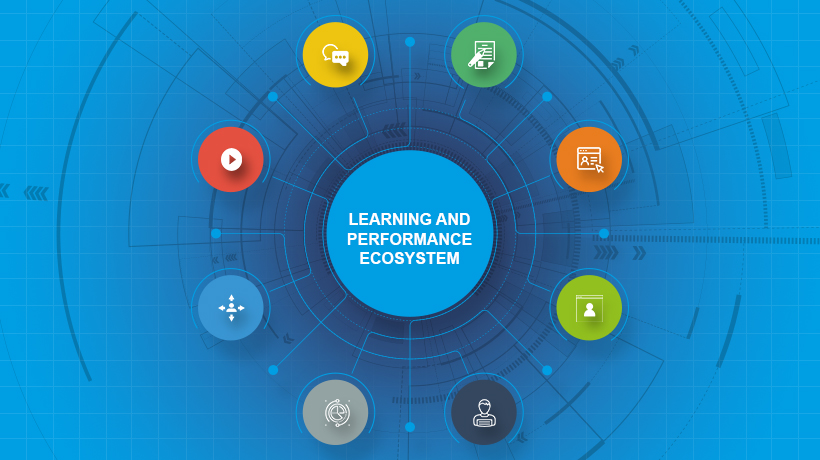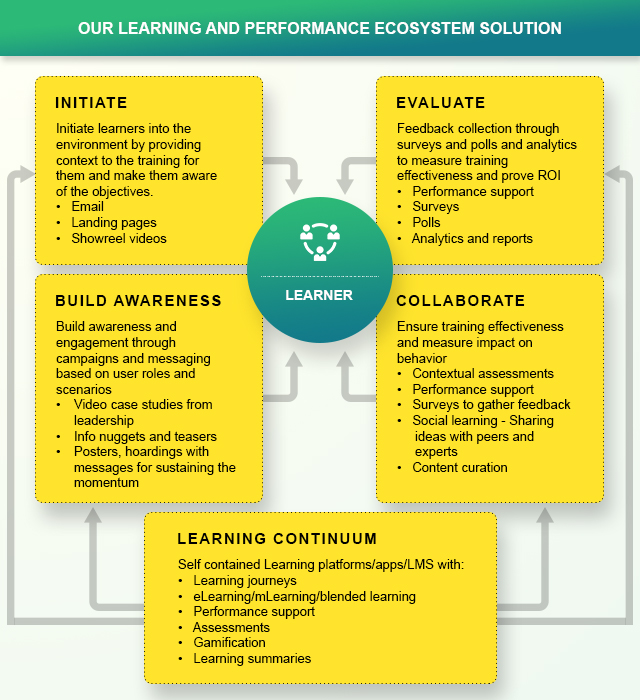
We are in a phase of rapid “learning transformation”. Higher focus on performance gain is paving the way for organizations to evaluate strategies beyond formal training. In this article, I provide answers to top 5 questions on why you should invest in a learning and performance ecosystem.
Invest In Learning And Performance Ecosystems And Enjoy The Gain
If we see how adults learn, we see the usage of multiple channels to learn. These range from structured training (formal learning), learning with and from others (social or collaborative learning) and learning from experiences on the job (experiential learning).
To achieve performance gain (as an outcome of learning) we need learning to happen on a continuous basis with a scope to explore and practice till we gain the required mastery.
It’s evident from these 2 pointers, that organizations cannot rely on formal training alone to achieve the crucial mandate of performance gain that eventually creates the impact businesses seek.
This is precisely where the approach of a learning and performance ecosystem fits in. In this article, I address top 5 questions associated with this, and my answers would help you understand the value of this approach and the gains you will see.
1. What Is A Learning And Performance Ecosystem?
One way to define a learning and performance ecosystem is:
“A learning and performance ecosystem enhances individual and organizational effectiveness by connecting people and supporting them with a broad range of content, processes, and technologies to drive performance”.
The value it offers has been summarized effectively here:
“A learning and performance ecosystem introduces new capabilities that integrate learning and performance solutions into the work environment. It minimizes the need for workers to leave work in order to learn, reduces work disruption, and places more learning opportunities directly into the flow of the work”.
Source here.
2. Why Should You Invest In Learning And Performance Ecosystem?
As I had highlighted earlier, the need to invest in a learning and performance ecosystem stems from the fact that we learn through multiple channels and these options to learn and eventually gain mastery must be available to the learners as part of your training delivery. The learning and performance ecosystem facilitates exactly this.
I, often, notice large outlays being set aside for formal or structured training. However, most formal training sessions consume from 2% to 5% of man-hours per year. With this small investment of time, the learners will at best obtain baseline proficiency. However, the desired levels of mastery will not happen.
To achieve the latter, the formal training must be supplemented by other forms of training (notably, Performance Support Tools) and channels that facilitate informal learning. These 2 aspects are intrinsic to a learning and performance ecosystem and can help organizations achieve the ROI once these are in place.
Usage of Performance Support Tools or PSTs also helps mitigate the “forgetting curve” rather effectively. As per this model, if there is no reinforcement post a training, we are likely to forget 80% of what we learned in the next 30 days. With a learning and performance ecosystem-based approach, you can use PSTs to reinforce the formal training. You can also use them as small nuggets for practice and assessments (validation of mastery).
As you would note from all these aspects, a traditional approach with a focus on only formal training is not adequate, and you must adopt a learning and performance ecosystem-based approach to enhance your existing training delivery.
3. What Are The Key Components Of A Learning And Performance Ecosystem?
The learning and performance ecosystem is designed with learners in the center. The channels and platforms that can facilitate learning are designed around them.
At EI, we use the following design. It features:
- Formal training
- Informal training
- Learning paths (that can be personalized)
- Special needs – Learning portals
- Platforms to facilitate social learning
- Channels to connect with coaches/mentors
- Content Curation
- Inclusive learning – Through contribution by learners
- Reporting and analytics

4. What Gains Would You See As You Invest In Learning And Performance Ecosystem?
The key gains you will see as you invest in a learning and performance ecosystem are:
- Adoption of a holistic approach.
With a focus on what learners need, what they want, and a learning environment that will ensure knowledge acquisition, knowledge application, and performance gain. - Creation of a rich learning culture.
With a focus on “learning as a continuum”. - Facilitation of social and collaborative learning.
This is recognized to be a significant part of your learning strategy. - Higher ROI.
Once various aspects of a learning and performance ecosystem are in place, you’ll see gains in learner engagement (and completion times), learning effectiveness (reflected in knowledge acquisition and application), and performance gain. All these will have a tangible and demonstrable impact on your ROI.
5. How Can You Leverage Current Trends And Technologies So As To Enhance Your Learning And Performance Ecosystem?
Some of the current trends and technologies that can be used very effectively to enhance your learning and performance ecosystem are:
- mLearning or mobile learning.
- Microlearning (for both formal training and as PSTs).
- Learning portals featuring learning paths, personalization, and content curation.
- Platforms for social learning and coaching/mentoring.
You’ll note that these current approaches align well with the concept of a learning and performance ecosystem and can be used to enhance your learning strategy manifold.
I hope this article provides insights on how you can use a learning and performance ecosystem to create “learning as a continuum” and eventually see higher ROI on your training spend. If you have any queries, do contact me at apandey@eidesign.net.
Read More



